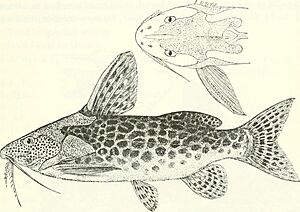Synodontis macrostigma facts for kids
Quick facts for kids Synodontis macrostigma |
|
|---|---|
 |
|
| Conservation status | |
| Scientific classification | |
| Genus: |
Synodontis
|
| Species: |
macrostigma
|
The Synodontis macrostigma, also known as the largespot squeaker, is a type of upside-down catfish. This fish lives in rivers and water systems in parts of Angola, Botswana, Namibia, South Africa, and Zambia. You can find it in the Cunene River, Okavango River, the upper Zambezi River, and the Kafue River.
A scientist named George Albert Boulenger first described this fish in 1911. He found specimens in the Okavango River in Botswana. The name macrostigma comes from two Greek words: makros, meaning "large", and stigma, meaning "spot". This name describes the big spots on the fish's sides.
Contents
What the Largespot Squeaker Looks Like
Like other Synodontis fish, the largespot squeaker has a strong, bony head. This head bone goes all the way back to its first dorsal fin spine. It also has a special bony part on its head called a humeral process. This part helps scientists tell different Synodontis species apart. For the largespot squeaker, this process is a bit longer than it is wide and has a rough, triangular shape.
Fish Whiskers: Barbels
This fish has three pairs of barbels, which are like whiskers. One pair is on its upper jaw (maxillary barbels). Two other pairs are on its lower jaw (mandibular barbels). The upper jaw barbels are long and straight. They can be almost as long as the fish's head. The outer pair of lower jaw barbels is nearly twice as long as the inner pair. Both lower pairs have short branches.
Fins and Spines
The front edges of the dorsal fin (on its back) and pectoral fins (on its sides) are stiff spines. The dorsal fin spine is about as long as the fish's head. It is slightly curved and smooth in the front, but rough on the back. The rest of the dorsal fin has seven soft rays. The pectoral fin spine is shorter than the dorsal spine and is rough on both sides.
The fish also has an adipose fin, which is a small, fleshy fin without rays. Its anal fin (near the tail) has four unbranched and eight branched rays. The tail fin, also called the caudal fin, is deeply forked, like a "V" shape.
Teeth and Mouth
All Synodontis fish have a special pad of teeth on the very front of their upper jaw. This is called a premaxillary toothpad. It has several rows of short, chisel-shaped teeth. In the largespot squeaker, this toothpad is short and wide.
On the lower jaw, the teeth are attached to flexible, stalk-like structures. These teeth are often described as "s-shaped" or "hooked". The number of teeth on the lower jaw helps identify the species. The largespot squeaker usually has about 20 to 26 teeth on its lower jaw.
Color and Size
The main body color of the largespot squeaker is brown on top. It gets lighter towards its belly. Its back and sides have large, round or oval blackish spots. Smaller spots can be seen on its head and fins.
The biggest largespot squeaker ever measured was about 17.1 centimeters (about 6.7 inches) long. In general, female Synodontis fish are a little bigger than males of the same age.
Where the Largespot Squeaker Lives and What It Does
In the wild, the largespot squeaker lives in the upper Zambezi River basin and the Okavango River system.
Reproduction and Life Cycle
Scientists don't know much about how most Synodontis species reproduce. However, they have found eggs in some female fish. It's thought that these fish likely lay their eggs during the flooding season, which is usually between July and October. It is believed that pairs of fish swim together when they are spawning (laying eggs).
What the Fish Eats
Synodontis fish are generally omnivores. This means they eat both plants and animals. Their diet can include insect larvae, algae, snails, clams, sponges, small crustaceans (like tiny shrimp), and even the eggs of other fish.
Growth Rate
These fish grow very quickly during their first year of life. After that, their growth slows down as they get older.


